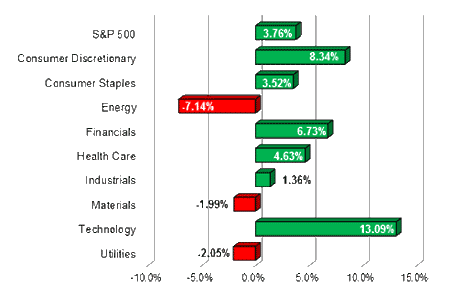
Market Commentary by Scott J. Brown, Ph.D., Chief Economist

The economic data were mixed, but mostly on the soft side of expectations. Retail sales were a bit weaker than expected in April. Industrial production improved, but partly reflected a surge in the output of utilities (more normal weather). Residential construction figures showed a moderate trend of improvement (from very low levels) in single-family homebuilding.
The minutes of the April 24th-25th monetary policy meeting showed that Fed officials were worried about the downside risks to growth from Europe and the potential for significantly tighter fiscal policy in the U.S. Fed officials were open to doing more (QE3), but only if the economic recovery were to lose momentum or downside risks intensified.
Greece was unable to form a coalition to run the government and so will have another set of elections on June 17th.
Most Greeks want to stay in the euro, but most also do not want the imposition of severe austerity. It’s expected that election results will push the country further from austerity. Fears that Greece may exit the euro (and the potential contagion that might follow) hammered global stock markets and led to a further flight to safety in U.S. Treasuries, sending the yield on the 10-year Treasury note to a record low. Thirty-year mortgage rates also hit a record low.Next week, the economic calendar thins out. The reports on new home sales and durable goods orders are two of the most notoriously erratic economic data releases (choppy and subject to large revisions). Hence, there’s a good chance for a surprise. Europe is expected to remain a key concern for U.S. investors. The weekend meeting of G-8 leaders should result in a strong statement of support for the euro area, but not much action. The bond market will close early on Friday, ahead of the three-day weekend. Looking ahead, the May Employment Report looms as the next major data point for the markets.
Indices
| Last | Last Week | YTD return % | |
| DJIA | 12442.49 | 12855.04 | 1.84% |
| NASDAQ | 2813.69 | 2933.64 | 8.00% |
| S&P 500 | 1304.86 | 1357.99 | 3.76% |
| MSCI EAFE | 1378.79 | 1446.19 | -2.39% |
| Russell 2000 | 754.33 | 791.75 | 1.81% |
Consumer Money Rates
| Last | 1-year ago | |
| Prime Rate | 3.25 | 3.25 |
| Fed Funds | 0.17 | 0.11 |
| 30-year mortgage | 3.73 | 4.55 |
Currencies
| Last | 1-year ago | |
| Dollars per British Pound | 1.583 | 1.621 |
| Dollars per Euro | 1.272 | 1.417 |
| Japanese Yen per Dollar | 79.380 | 81.360 |
| Canadian Dollars per Dollar | 1.017 | 0.976 |
| Mexican Peso per Dollar | 13.812 | 11.758 |
Commodities
| Last | 1-year ago | |
| Crude Oil | 92.56 | 96.91 |
| Gold | 1576.30 | 1480.50 |
Bond Rates
| Last | 1-month ago | |
| 2-year treasury | 0.29 | 0.27 |
| 10-year treasury | 1.72 | 1.98 |
| 10-year municipal (TEY) | 3.00 | 3.25 |
Treasury Yield Curve – 5/18/2012
S&P Sector Performance (YTD) – 5/18/2012
Economic Calendar
| May 22nd |
— |
Existing Home Sales (April) |
| May 23rd |
— |
New Home Sales (April) |
| May 24th |
— |
Jobless Claims (week ending May 19th) Durable Goods Orders (April) |
| May 25th |
— |
Consumer Sentiment (May) |
| May 28th |
— |
Memorial Day Holiday (markets closed) |
| May 29th |
— |
Consumer Confidence (May) |
| May 30th |
— |
Real GDP (1Q12, 2nd estimate) |
| June 1st |
— |
Employment Report (May) ISM Manufacturing Index (May) |
| June 20th |
— |
FOMC Policy Decision Bernanke Press Briefing |
Important Disclosures
US government bonds and treasury bills are guaranteed by the US government and, if held to maturity, offer a fixed rate of return and guaranteed principal value. US government bonds are issued and guaranteed as to the timely payment of principal and interest by the federal government. Treasury bills are certificates reflecting short-term (less than one year) obligations of the US government.
Commodities trading is generally considered speculative because of the significant potential for investment loss. Markets for commodities are likely to be volatile and there may be sharp price fluctuations even during periods when prices overall are rising. Specific sector investing can be subject to different and greater risks than more diversified investments.
Tax Equiv Muni yields (TEY) assume a 35% tax rate on triple-A rated, tax-exempt insured revenue bonds.
![]() Material prepared by Raymond James for use by its financial advisors.
Material prepared by Raymond James for use by its financial advisors.
The information contained herein has been obtained from sources considered reliable, but we do not guarantee that the foregoing material is accurate or complete. Data source: Bloomberg, as of close of business May 17th, 2012.
©2012 Raymond James Financial Services, Inc. member FINRA / SIPC.




